Language/Hebrew/Culture/Hebrew-Poetry
 Հայերէն
Հայերէն Български език
Български език 官话
官话 官話
官話 Hrvatski jezik
Hrvatski jezik Český jazyk
Český jazyk Nederlands
Nederlands English
English Suomen kieli
Suomen kieli Français
Français Deutsch
Deutsch हिन्दी
हिन्दी Magyar
Magyar Bahasa Indonesia
Bahasa Indonesia فارسی
فارسی Italiano
Italiano 日本語
日本語 Қазақ тілі
Қазақ тілі 한국어
한국어 Lietuvių kalba
Lietuvių kalba Νέα Ελληνικά
Νέα Ελληνικά Şimali Azərbaycanlılar
Şimali Azərbaycanlılar Język polski
Język polski Português
Português Limba Română
Limba Română Русский язык
Русский язык Српски
Српски Español
Español العربية القياسية
العربية القياسية Svenska
Svenska Wikang Tagalog
Wikang Tagalog தமிழ்
தமிழ் ภาษาไทย
ภาษาไทย Türkçe
Türkçe Українська мова
Українська мова Urdu
Urdu Tiếng Việt
Tiếng Việt
| ◀️ Landmarks — Previous Lesson | Next Lesson — Hebrew Proverbs ▶️ |
Hebrew poetry is rich in imagery and language. It has a long history that goes back to biblical times. In this lesson, we will explore the unique features of Hebrew poetry, including traditional meters, rhyme, and imagery.
Don't hesitate to look into these other pages after completing this lesson: Israeli Society & Israel Timeline.
Features of Hebrew Poetry
Hebrew poetry reflects the culture and history of the Jewish people. It is characterized by the use of metaphors, similes, and parallelism. Biblical Hebrew poetry was performed in a style known as chanted prose. It relied heavily on wordplay, alliteration, and repetition.
One unique characteristic of Hebrew poetry is parallelism. This technique involves repeating a thought or phrase in a different way to create rhythm and emphasis. There are three types of parallelism used in Hebrew poetry:
- Synonymous parallelism, where the second line repeats the sense of the first line, using different words.
- Antithetic parallelism, where the second line is the opposite of the first line.
- Synthetic parallelism, where the second line builds on or completes the thought of the first line.
Hebrew poetry also uses traditional meters, such as the shirah meter, which is based on the meter of the Song of the Sea in Exodus 15. This meter consists of 3 stressed syllables followed by 2 unstressed syllables. Another commonly used meter is the qinah meter, a lamentation meter that emphasizes sorrow and grief.
Imagery is another important feature of Hebrew poetry. It uses nature, animals, and everyday objects as metaphors to represent emotions and ideas. For example, a dove may symbolize peace, a lion may symbolize strength, and a tree may symbolize growth and stability.
Examples of Hebrew Poetry
Hebrew poetry has a long and rich history. Some notable poets throughout history include:
- King David, who wrote many of the Psalms in the Hebrew Bible.
- Rabbi Yehuda HaLevi, who wrote the famous love poem "My Heart Is in the East."
- Haim Nachman Bialik, who wrote about modern Jewish life and the challenges faced by the Jewish people.
Here is an example of a Hebrew poem by Haim Nachman Bialik:
| Hebrew | Pronunciation | English |
|---|---|---|
| עַל הָאַיָּל הַצָּהוּב | Al ha-ayal ha-tsahuv | On the yellow deer |
| שֶׁבַע פְעָמִים נָשַׁקְתָּ | Sheva pe'amim nashakta | You kissed her seven times |
| שֶׁבַע פְעָמִים בַּמְּדִינָה | Sheva pe'amim ba-medinah | Seven times in the country |
| וְבַמַּשְׁבֵּצָה הֵישַׁבְתָּ | Ve-ba-mashbe'tzah heishavta | And you sat in the ruins |
| כְּמוֹ הַמִּצְפֶּה שְׁנַאיָּיו | Kemo ha-mitzpeh shenaiyav | Like the watchtower of your enemies |
| מָנָה שָׁם לְבָבֶךָ | Manah sham le'vavecha | Your heart counted the days |
| בַּיָּאָר כְּנָחַל אֲזוֹבֵי | Ba-ya'ar kenachal azovei | In the forest like the creek of willows |
| שֵׁם הַיָּעַר אָהֳלִים | Shem ha-ya'ar ahaleem | The name of the forest is tents |
| וְהִמְתַּאִים עִם הַעֲשָׁנִים | Vehimta'im im ha-ashanim | And it resonates with the clouds. |
Conclusion
Hebrew poetry has a long and rich history, with unique features that reflect the culture and history of the Jewish people. It is characterized by the use of parallelism, traditional meters, and imagery. Hebrew poetry is an important aspect of Hebrew literature and culture, and is still studied and appreciated today.
Sources
- A New Sound in Hebrew Poetry
- Women's Hebrew Poetry on American Shores | Wayne State ...
- Hebrew Poetry in Spain - Jewish Studies - Oxford Bibliographies
Now that you've completed this lesson, don't stop learning! Check out these related topics: Israeli Cuisine & Hebrew Proverbs.
Videos
HEBREW POETRY translated יערת דבש by Rabbi Najara - YouTube
The Zionist Movement through Hebrew poetry | 26.1.2021 - YouTube
Hebrew Poetry of Life & Love: Rachel Bluwstein, Leah Goldberg and ...
A History of Hebrew Part 13: The Culture and Language Connection ...
Other Lessons
| ◀️ Landmarks — Previous Lesson | Next Lesson — Hebrew Proverbs ▶️ |

